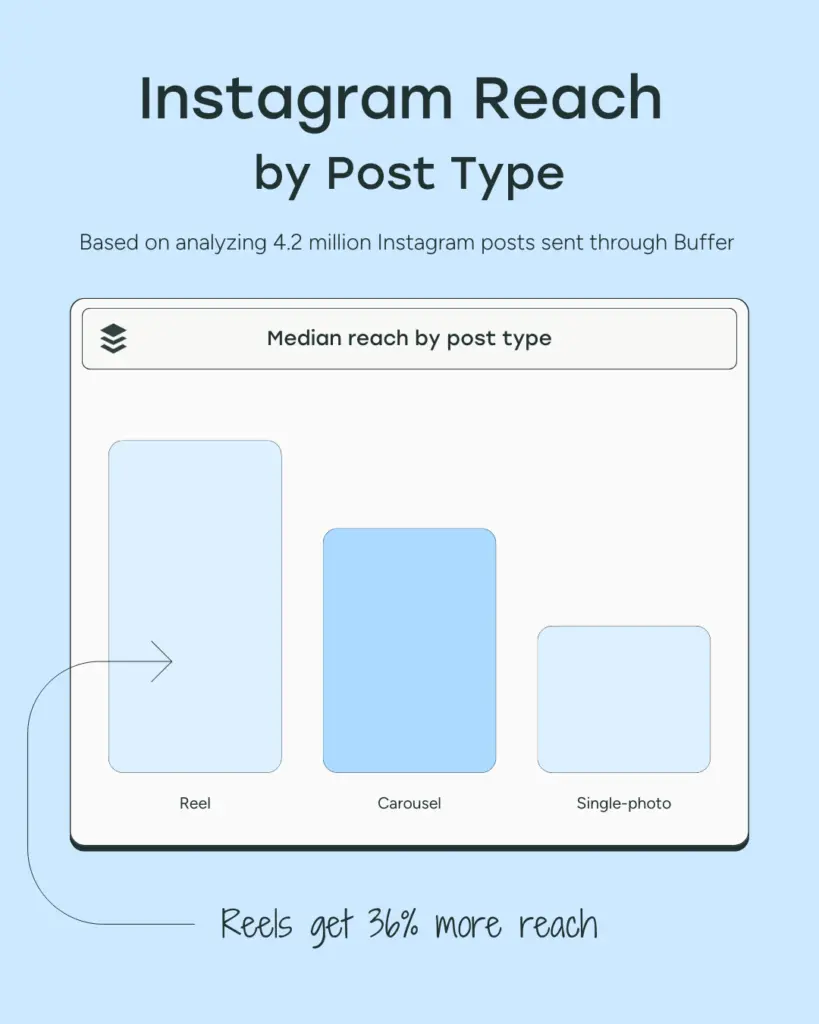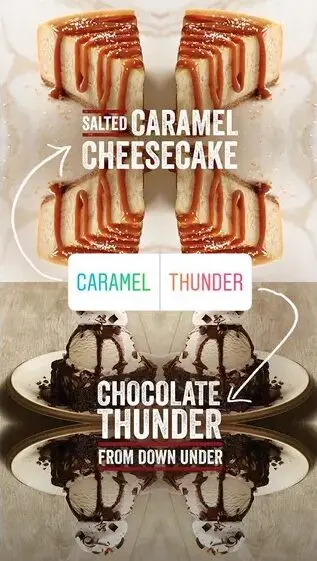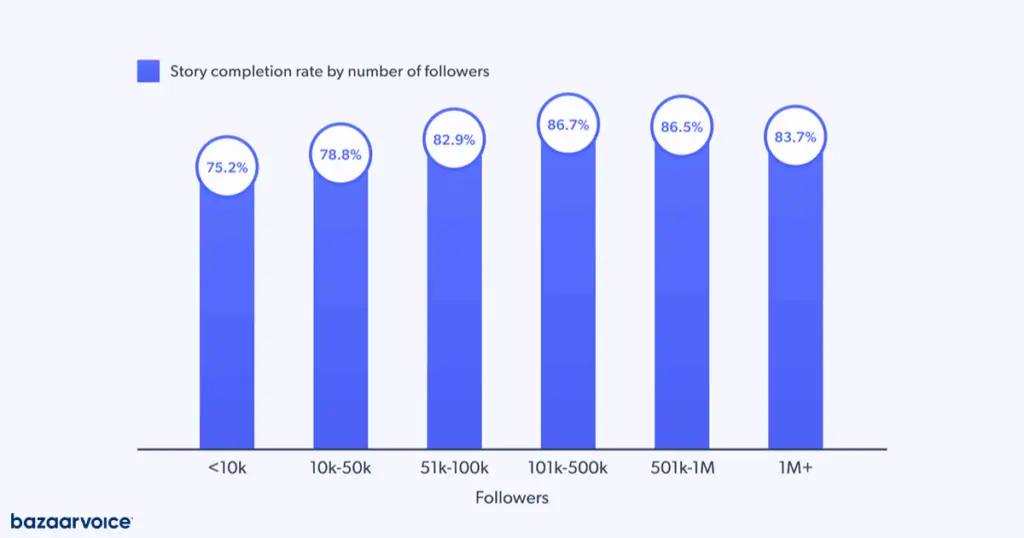When should a brand post a Reel and when is a Story the smarter move?
It’s a question marketers are asking more urgently than ever as Instagram’s algorithm evolves and short-form formats collide. In 2025, Meta is doubling down on Reels for reach, expanding runtime to three minutes, and promoting Trial Reels to test with non-followers. At the same time, Stories continue to dominate follower engagement, with marketers allocating 31% of their Instagram budgets to the format.
Reels fuel discovery, Stories drive conversion. But many brands still treat them interchangeably, blurring performance data and creative strategy.
This guide breaks down how the two formats now operate in tandem, when to use each, how creative and CTAs differ, and what metrics actually matter, so your Instagram strategy aligns with audience behavior, not algorithmic guesswork.
Reels: Built for Reach and Discovery
The Discovery Engine Behind Instagram Reach
Meta has openly framed Reels as the best way to “find new audiences,” while Stories remain ephemeral and follower-first. That’s because Reels are distributed far beyond your follower base through dedicated surfaces like the Reels tab, Explore, and the in-feed recommendations system.
A 2024 Buffer study analyzing four million posts found that Reels deliver 2.25× higher reach than single-image posts and 1.36× more than carousels. For brands fighting diminishing organic visibility, Reels represent the only scalable, algorithmically favored way to reach new users without paid amplification.
The discovery bias is also strategic. Meta’s Q1 2025 earnings call confirmed that “time spent watching Reels increased 20% year-over-year,” which directly correlates with advertiser demand for top-of-funnel impressions. Instagram’s expansion of Reels’ runtime to three minutes gives marketers more space to develop product narratives while maintaining short-form sensibility.
Trial Reels: De-Risking Creative Decisions
A quiet but important shift came with Meta’s rollout of Trial Reels — a testing feature that lets creators and brands share content with non-followers first, before deciding whether to publish it broadly.
This change de-risks creative experimentation. Instead of pushing untested content to your audience, you can now see how a cold audience responds. Early case studies suggest substantial upside. Canadian soccer creator Alayah Pilgrim reportedly gained 60,000 followers after testing a clip through Trial Reels, proving how small iterations — captions, pacing, hooks — can be validated in real time.
For brands, Trial Reels are particularly powerful in launch phases. A cosmetics company could pre-test three variants of a product demo (voiceover-led, trending-audio, and testimonial-driven) to identify which version maximizes non-follower engagement before investing ad spend or influencer seeding behind it.
Pacing and Creative Adjustments for 3-Minute Reels
The expansion to 3-minute Reels changes not just format length but storytelling rhythm. Longer Reels require segmentation: think of them as micro-scenes stitched into a single vertical narrative.
The first three seconds must still hook, a visual disruption, human emotion, or promise of payoff, but sustaining attention now means adding tempo shifts, text overlays, and visual resets every 10-15 seconds.
Brands like Sephora have successfully adopted this rhythm. Their Reels often blend quick tutorials, jump cuts, and mid-roll product tags that keep retention high across longer clips.
Netflix takes a similar approach, remixing behind-the-scenes content from new releases into serialized Reels that play like mini-trailers, maintaining engagement beyond core fans.
CTAs for Discovery, Not Conversion
Reels are top-of-funnel assets. The best calls-to-action aren’t “Buy Now” but “Watch next,” “Follow for more,” or “See the full tutorial in Stories.” The goal is to earn the second touchpoint, not force a conversion from an unfamiliar viewer. Once a Reel performs well with non-followers, it becomes a bridge to Stories — where intent and interaction deepen.
Read also:
Read also:
Check out the The Top 5 Ways Brands Can Leverage Instagram Reels In Their Marketing Strategy
Check it out
Stories: Designed for Connection and Conversion
If Reels are your megaphone to the world, Stories are your one-to-one conversation. They’re built not for reach, but for retention; the format where loyalty, trust, and purchase intent quietly accumulate.
In 2025, Meta continues to emphasize Stories as follower-first spaces, ideal for brands that want to deepen relationships rather than chase impressions.
Why Stories Still Matter in 2025
Despite Instagram’s heavier investment in Reels discovery, Stories remain a core marketing channel — and the budgets prove it. Marketers in America allocated 31% of their Instagram marketing budgets to Stories in 2025, underscoring how the feature has matured from a behind-the-scenes content format into a full-funnel conversion tool. That spend reflects Stories’ proven ability to convert warm audiences rather than attract new ones.
Stories’ design lends itself to this purpose: Ephemeral posts, sequential storytelling, and interactive stickers like polls, quizzes, and link buttons.
These tools transform one-way communication into dialogue. The results are stronger brand recall, repeat engagement, and a measurable lift in intent — outcomes that static feed posts or trending Reels often can’t replicate.
Turning Attention Into Action
Because Stories reach an audience that already follows you, they perform best when used to activate rather than introduce. A follower who sees a new product line in a Reel may swipe to your profile — but they’ll likely convert after watching your Stories. That’s where brands deliver detail, urgency, and context.
Ulta Beauty’s “Gorgeous Hair Event” exemplifies this behavior. The retailer used full-screen, Story-native two-card video carousel ads with “Learn More” CTAs, generating a 63% higher return on ad spend and 1.8× higher click-through rate compared to their previous single-video Story format.
The improvement came from tailoring the creative to the Story environment — fast vertical pacing, clear framing, and familiar product-in-use visuals that encouraged viewers to keep tapping forward.
How to Structure Stories That Convert
A strong Story sequence follows three stages:
- Hook with context: Open with a relatable visual or question — the moment that earns the viewer’s tap forward. “Your foundation oxidizing again?” feels conversational and instantly situates the problem.
- Build participation: Use one interactive sticker midway — a poll, quiz, or slider — to transform passive watching into an active touchpoint. Engagement here signals interest to the algorithm, keeping your brand top-of-feed.
- End with a single CTA: Link stickers, countdowns, and reply prompts work best when they appear only once and after value has been delivered. The frame’s purpose is to make acting feel effortless, not transactional.
Measuring What Matters
Unlike Reels, where discovery is the primary metric, Stories should be evaluated through interaction density — the depth and frequency of actions your existing followers take. Track completion rates, tap-forwards, link taps, and replies rather than raw reach to understand real engagement.
According to Bazaarvoice, the average Instagram Stories completion rate across all categories and follower sizes is 82%, confirming that users are willing to watch Stories through to the end when pacing and creative sequencing are strong. This makes completion rate one of the clearest indicators of Story health and content relevance.
The 31% budget allocation marketers dedicate to Stories reflects this understanding: Stories aren’t about chasing new audiences; they’re about converting existing ones.
In an environment where attention is fleeting, maintaining an always-on Story cadence gives brands a recurring, high-intent presence in followers’ daily routines — arguably the most valuable real estate on Instagram today.
Read also:
Read also:
Check out the 7 Creative Ways to Use Instagram Stories Polls
Check it out
Creative & CTA Contrast: A Quick Decision Framework
While Reels and Stories share the same format dimensions, they occupy completely different psychological spaces. Understanding this creative and CTA divide is what separates brands that go viral once from those that build lasting engagement cycles.
Creative Contrast: Designing for Discovery vs. Depth
The creative DNA of a Reel versus a Story starts with intent.
- Reels thrive on novelty and pace. The opening three seconds determine success: movement, pattern disruption, or trending audio cues signal to the algorithm that the content deserves wider reach.
- Stories, meanwhile, reward familiarity. Audiences consume them expecting continuity, updates, or personal voice — not trends. This makes them ideal for sequential messaging, product education, or brand storytelling that unfolds over multiple frames.
The TSA (Transportation Security Administration) offers a surprisingly sharp model for this creative divide. Its Reels feature humorous, shareable travel tips like “This layover must have been in-tents!” – short, upbeat, and formatted to reach non-followers through Explore.
These clips regularly generate millions of views and extensive media pickup because they balance utility with entertainment.
In contrast, the TSA uses Stories to serve its loyal follower base with time-sensitive updates, Q&As, and policy reminders, such as seasonal travel alerts or TSA PreCheck tips. Those Story sequences use stickers and countdowns to increase saves and replies — tactics designed for returning viewers rather than new discovery.
The combination proves that even a government agency can master the Reels-for-reach, Stories-for-relationship playbook: Reels build awareness; Stories convert attention into trust and habit.
CTA Logic: From Curiosity to Conversion
Calls-to-action should mirror the user mindset. Someone watching a Reel is in exploration mode — they’re just meeting the brand. Someone viewing a Story is in decision mode — they’ve likely interacted before.
| Goal | Best Format | CTA Style | Example Metric |
|---|---|---|---|
| Reach new audiences | Reels | “Follow for more,” “Watch till the end,” “Tag a friend” | Non-follower reach, shares |
| Drive engagement and retention | Stories | “Vote below,” “Reply to join,” “Tap link to shop” | Replies, link taps, completion rate |
| Convert or re-engage | Stories (paid or organic) | “Swipe up,” “Claim offer,” “Set reminder” | CTR, ROAS, conversions |
The CTA in a Reel should be soft and curiosity-based — a nudge to watch another clip or follow the account. In Stories, it can be direct: prompting action through link stickers, countdowns, or limited-time frames. The creative language should shift from “see more” to “do this.”
Applying the Framework
The fastest way to decide which format to prioritize is to anchor every campaign in a single intent question: “Am I trying to attract, or am I trying to convert?”
- Use Reels when the goal is reach, awareness, or algorithmic discovery. Test new hooks or audio trends through Trial Reels to see what resonates with cold audiences before expanding distribution.
- Use Stories when you’re ready to engage followers through daily touchpoints, drops, and offers that drive measurable action.
Marketers increasingly use both in sequence — launching a Reel to build awareness, then following it with Stories to convert that attention into replies, link taps, or sales. This approach mirrors consumer behavior on the platform: audiences discover first, decide later.
The creative and CTA contrast isn’t about choosing one format over the other; it’s about orchestrating both in rhythm. Reels pull people in — Stories keep them close.
Measuring Impact: From Non-Follower Reach to Replies
The difference between Reels and Stories isn’t just creative — it’s mathematical. Each format serves a distinct purpose, and the metrics that define success for one are meaningless for the other. Reels measure discovery. Stories measure depth. Understanding how to interpret both is the only way to prove performance beyond vanity numbers.
Reels Metrics That Indicate True Discovery
To measure that discovery accurately, focus on four core metrics:
- Non-Follower Reach: The single most important number for Reels. It shows how far your content has traveled outside your existing audience. High ratios of non-follower reach (>70%) indicate the algorithm is surfacing your Reel broadly on Explore and the Reels tab.
- Watch Time & Replays: Instagram prioritizes Reels that hold attention and are re-watched — these behaviors feed the ranking system. A Reel’s early retention rate determines whether it will expand into broader recommendation pools.
- Shares & Saves: These are viral signals. Each share acts as implicit validation, often triggering secondary reach waves.
- Trial Reels Results: Trial Reels allow creators to publish privately to non-followers to test performance. The results give brands predictive indicators of which creative direction will scale.
Instagram’s Adam Mosseri breaks down these in more detail:
Together, these metrics define whether your Reels are doing their job: expanding your audience footprint and earning algorithmic exposure.
Stories Metrics That Signal Depth and Conversion
Stories, on the other hand, measure what happens after discovery. For Stories, the key performance metrics are:
- Completion Rate: Indicates pacing and audience relevance. Anything near or above 80% shows the sequence is holding attention.
- Replies and DMs: The strongest signal of relational engagement. These responses feed directly into future ranking for that user.
- Sticker Interactions (polls, quizzes, sliders): Track engagement quality; interactive stickers often increase total watch time across a sequence.
- Link Taps: The clearest conversion metric — whether driving to a product page, signup form, or campaign landing page.
Turning Metrics Into Strategy
Evaluating Reels and Stories side by side only makes sense when you treat them as complementary funnel stages.
| Funnel Stage | Format | Primary KPIs | Strategic Goal |
|---|---|---|---|
| Awareness | Reels | Non-follower reach, shares, replays | Discoverability and top-of-funnel growth |
| Consideration | Stories | Completion rate, replies, sticker taps | Engagement depth and brand affinity |
| Conversion | Stories (Paid or Organic) | Link taps, swipe-ups, ROAS | Direct action and remarketing efficiency |
When brands analyze both formats holistically, the pattern becomes clear: Reels expand your audience; Stories monetize it.
Reels should be judged by how far they travel outside your community. Stories should be judged by how many people they move closer to action. The metrics may live in the same dashboard, but they represent two very different moments in the customer journey — awareness earned, and attention converted.
Read also:
Reels Reach, Stories Convert: The Two Lanes of Instagram Growth
Instagram’s ecosystem now runs on a dual engine — Reels for reach, Stories for retention. Reels amplify discovery by pushing content beyond your existing audience; Stories convert that attention into meaningful action. Marketers who separate these roles instead of blending them see stronger ROI and cleaner creative direction.
The takeaway is simple: treat Reels as your awareness accelerator — the place to experiment, test, and attract. Then use Stories as your conversion and relationship platform, where followers get context, credibility, and calls to act. Together, they form a self-sustaining loop: Reels bring new people in, Stories keep them coming back.
In 2025, Instagram’s smartest brands aren’t choosing between formats — they’re sequencing them. Those who understand when to post, how to pace, and what to measure are the ones turning impressions into outcomes.
Frequently Asked Questions
How can brands increase the visibility of their Reels in 2025?
Posting consistency, timing, and early engagement still influence reach, but optimizing upload windows matters most. Research on the best times to post on Instagram Reels shows that weekday mornings between 5 AM-12 PM and early evenings consistently outperform late uploads for organic visibility.
What are Instagram’s latest collaborative Story features?
Instagram recently introduced Storylines and Collaborative Stories, letting users and brands co-create ephemeral content within shared threads — ideal for multi-creator takeovers and audience participation campaigns.
How can marketers ensure their Reels meet technical requirements?
Before publishing, always confirm the Instagram video size specifications for Reels to prevent compression or cropping issues, especially when repurposing content from TikTok or YouTube Shorts.
What’s the most effective way to build a diversified content mix on Instagram?
A structured posting rhythm that combines Reels, Stories, carousels, and static posts aligns with the Instagram content playbook many creators now use to balance reach, retention, and brand voice.
Can creators directly monetize their Reels?
Yes. Eligible creators can access payout options like performance-based bonuses and ad placement revenue through the Instagram Reels monetization program, which continues expanding across regions in 2025.
What stats show how Reels perform compared to other formats?
Recent Instagram Reels stats reveal higher engagement rates and faster follower growth potential than traditional posts, reinforcing why brands prioritize Reels for discovery campaigns.
How do users download or save their Reels for repurposing?
Instagram now allows users to download Instagram Reels with original audio intact, making it easier for teams to archive content for paid ads, compilations, or cross-platform use.
What new engagement tools are hidden in Instagram’s latest updates?
Marketers are experimenting with the Instagram secret code feature, which adds customizable phrases that unlock exclusive content or offers — a playful tactic for driving Story interaction and loyalty.




